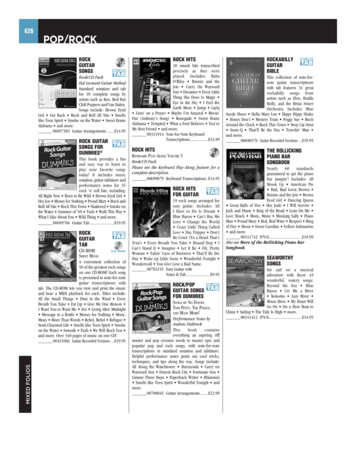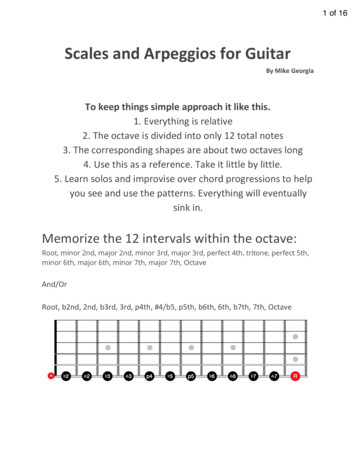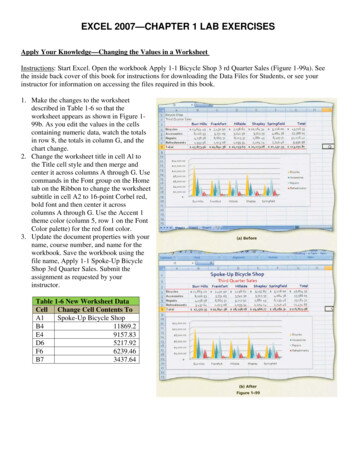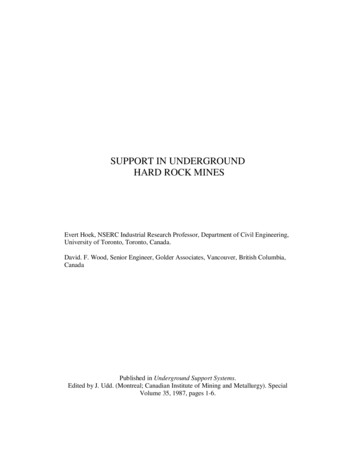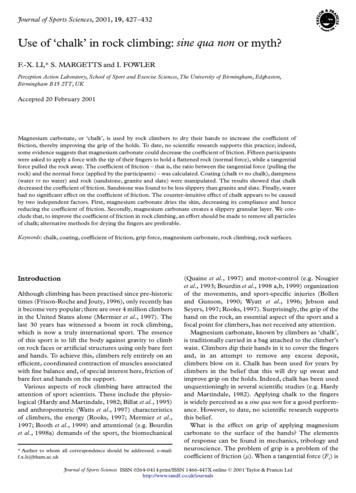
Transcription
Journal of Sports Sciences, 2001, 19, 427 432Use of chalk’ in rock climbing: sine qua non or myth?F.-X. LI,* S. MARGETTS and I. FOWLERPerception Action Laboratory, School of Sport and Exercise Sciences, The University of Birmingham, Edgbaston,Birmingham B 15 2TT, UKAccepted 20 February 2001Magnesium carbonate, or chalk’ , is used by rock climbers to dry their hands to increase the coeý cient offriction, thereby improving the grip of the holds. To date, no scienti c research supports this practice; indeed,some evidence suggests that magnesium carbonate could decrease the coeý cient of friction. Fifteen participantswere asked to apply a force with the tip of their ngers to hold a attened rock (normal force), while a tangentialforce pulled the rock away. The coeý cient of friction that is, the ratio between the tangential force (pulling therock) and the normal force (applied by the participants) was calculated. Coating (chalk vs no chalk), dampness(water vs no water) and rock (sandstone, granite and slate) were manipulated. The results showed that chalkdecreased the coeý cient of friction. Sandstone was found to be less slippery than granite and slate. Finally, waterhad no signi cant eþ ect on the coeý cient of friction. The counter-intuitive eþ ect of chalk appears to be causedby two independent factors. First, magnesium carbonate dries the skin, decreasing its compliance and hencereducing the coeý cient of friction. Secondly, magnesium carbonate creates a slippery granular layer. We conclude that, to improve the coeý cient of friction in rock climbing, an eþ ort should be made to remove all particlesof chalk; alternative methods for drying the ngers are preferable.Keywords: chalk, coating, coeý cient of friction, grip force, magnesium carbonate, rock climbing, rock surfaces.IntroductionAlthough climbing has been practised since pre-historictimes (Frison-Roche and Jouty, 1996), only recently hasit become very popular; there are over 4 million climbersin the United States alone (Mermier et al., 1997). Thelast 30 years has witnessed a boom in rock climbing,which is now a truly international sport. The essenceof this sport is to lift the body against gravity to climbon rock faces or arti cial structures using only bare feetand hands. To achieve this, climbers rely entirely on aneý cient, coordinated contraction of muscles associatedwith ne balance and, of special interest here, friction ofbare feet and hands on the support.Various aspects of rock climbing have attracted theattention of sport scientists. These include the physiological (Hardy and Martindale, 1982; Billat et al., 1995)and anthropometric (Watts et al., 1997) characteristicsof climbers, the energy (Rooks, 1997; Mermier et al.,1997; Booth et al., 1999) and attentional (e.g. Bourdinet al., 1998a) demands of the sport, the biomechanical* Author to whom all correspondence should be addressed. e-mail:f.x.li@bham.ac.uk(Quaine et al., 1997) and motor-control (e.g. Nougieret al., 1993; Bourdin et al., 1998 a,b, 1999) organizationof the movements, and sport-speci c injuries (Bollenand Gunson, 1990; Wyatt et al., 1996; Jebson andSeyers, 1997; Rooks, 1997). Surprisingly, the grip of thehand on the rock, an essential aspect of the sport and afocal point for climbers, has not received any attention.Magnesium carbonate, known by climbers as chalk’ ,is traditionally carried in a bag attached to the climber’swaist. Climbers dip their hands in it to cover the ngersand, in an attempt to remove any excess deposit,climbers blow on it. Chalk has been used for years byclimbers in the belief that this will dry up sweat andimprove grip on the holds. Indeed, chalk has been usedunquestioningly in several scienti c studies (e.g. Hardyand Martindale, 1982). Applying chalk to the ngersis widely perceived as a sine qua non for a good performance. However, to date, no scienti c research supportsthis belief.What is the eþ ect on grip of applying magnesiumcarbonate to the surface of the hands? The elementsof response can be found in mechanics, tribology andneuroscience. The problem of grip is a problem of thecoeý cient of friction (m). When a tangential force (Ft) isJournal of Sports Sciences ISSN 0264-0414 print/ISSN 1466-447X online Óhttp://www.tandf.co.uk/journals2001 Taylor & Francis Ltd
428exerted on a surface, it will tend to move in the directionof the force applied. To prevent this movement, afriction force normal to the surface (Fn ) can be applied.The ratio between tangential force and normal forcede nes the static coeý cient of friction: m Ft/Fn . Thecoeý cient is roughly constant for any pair of surfaces.The coeý cient of friction can be aþ ected by the introduction of another substance between the two surfaces;this is the way lubrication works. For instance, a layerof oil is often used to reduce the coeý cient of frictionbetween two metallic surfaces. Conversely, removingany trace of grease or humidity can increase the coeý cient of friction. This has been the basis for therationale leading to the almost unchallenged use ofchalk in climbing: dry skin grips better, chalk dries theskin, so by regular application of chalk one increasesthe coeý cient of friction between the skin on the handsand the climbing surfaces. But is it that straightforward?For solid surfaces, friction is proportional to thenormal force applied and it is independent of thesurface area. However, skin or the stratum corneum,the outermost layer of skin is a compliant material. It isabout 10 15 mm thick. It behaves more like an elastomeror thermoplastic than a solid body (Johnson et al.,1993). The properties of this biomaterial depend onmany factors, including the percentage of water, pH andtemperature. Interestingly, Johnson et al. (1993) showedthat the addition of water increases the friction of dryskin. It would appear that the main eþ ect of water isto increase the compliance of the surface asperities andhence the contact area. Frequent application of chalkmay decrease the percentage of water in the skin and,therefore, decrease its compliance. Moreover, Wyattet al. (1996) found that the splitting of the skin pads ofthe ngertips, a common injury among climbers, is duein part to the use of chalk and its desiccating eþ ect. Itappears that, at least from a tribological and medicalpoint of view, the overuse of chalk can have the oppositeeþ ect to that intended.Chalk is used to remove water and sweat. Sweat isproduced naturally by more than 2.5 million subcutaneous sudoriferous glands. Sweat is a hypotonicsolution with a content of 99% water (Marieb, 1992).Owing to the presence of sweat and the accumulationof various greasy substances collected during themanipulation of objects, the skin can be covered by athin slippery deposit. Johansson and Westling (1984)have shown that, immediately after washing and dryingthe skin, the coeý cient of friction increases. Therefore, there is an advantage in drying the hands. However, Cadoret and Smith (1996) showed that applyingtalcum powder to the skin can decrease the coeý cientof friction. Magnesium carbonate could have the sameeþ ect, so that it may not be the best way to increase thecoeý cient of friction.Li et al.No scienti c results directly support the use of chalkin rock climbing. Indeed, some studies (Johnson et al.,1993; Cadoret and Smith, 1996; Wyatt et al., 1996)cast doubt on its usefulness. The aim of this study wasto determine the eþ ect of magnesium carbonate on thecoeý cient of friction and its potential interaction withdampness and type of rock. We hypothesized that chalkwould not improve the coeý cient of friction for alreadydry hands and that applying water would decrease thecoeý cient of friction.MethodsParticipantsFifteen students aged 20 22 years volunteered to participate in the experiment. They had no cuts or abrasionsto the pads of the ngers and were all unaware of thehypotheses to be tested.ApparatusA purpose-built set-up was used in the experiment. Acarriage moved freely on ball bearings and two parallelsteel rods (Fig. 1). The rods were mounted on fourstrain gauges (RS 632-168, 5 mm). The strain gaugeswere calibrated and the total normal force applied bythe carriage was calculated. A non-stretchable kevlarrope (diameter 4 mm) was attached to the carriage.A weight (3.5 kg) was suspended on the rope via apulley. A strain gauge (RS 632-180, 5 mm), rigidlymounted between the rope and the carriage, was used tomeasure the force applied to the carriage by the weight.This tangential force was 29 N for all trials; thiswas suý ciently high to give accurate and meaningfulresults but did not result in the participants becomingtoo fatigued. The carriage was attached to a xedpotentiometer to measure linear displacements.Opposite to the rope and at the extremity of the rails,an armrest was mounted level with the carriage. Theapparatus was mounted on a table and the participantswere seated side-on to it so that the forearm and palm ofthe hand were placed on the armrest, with the ngersslightly above the carriage. A strap running over theback of each participant’ s hand was adjusted to preventthe hand being lifted.Three types of rock were used: sandstone, slate andgranite. These rock samples do not have the sameexternal structure or appearance. Sandstone is theroughest, while slate is the smoothest. The roughnesshas a strong in uence on the ability to avoid slippage.However, the wide variability in the geological formation of rock in natural settings renders the reproductionof a real-life environment impractical. It would also be
429Coeý cient of friction in rock climbingFig. 1. Schematic side view of the set-up. The hand is on the armrest and the ngers apply a force normal to the rock while atangential force pulls the rock away from the participant.very diý cult, if not impossible, to compare diþ erenttypes of rock samples. Therefore, to ensure that thesurface texture of the rock samples was comparable,they were lapped using a vibrator machine and looseabrasive powder (Silicon Carbide of grit size 180). Theabrasive powder removed the material by scratchingthe surface until an even surface was obtained. Thistreatment, classically used in geology (Allman andLawrence, 1972), resulted in a rough but homogeneoussurface across each rock sample, hence making comparisons between them possible. All rock samples werecut to the same dimensions (125 145 mm). Theywere mounted on the carriage and the participant’ shand fell naturally on it. All signals from the transducerswere recorded continuously at 1000 Hz on a personalcomputer using an A/D card (PCI-M10-16XE-10 NI)and a purpose-designed program under Labview.review, see Turrell et al., 2001). The participantswere instructed not to try to stop the movement of thecarriage once it had started to slip. They practised untilthey were familiar with the apparatus and the task.Two hand dampness conditions (dry or wet) werecrossed with two coating conditions (no chalk or chalk)and three types of rock (sandstone, granite and slate).This repeated-measure design resulted in four handconditions:participants cleaned their hands with water· Dry:and mild detergent to remove sweat and any other·Design and procedureAfter reading the instructions and signing a consentform, the participants were required to clean and drytheir hands. Then, they sat next to the apparatus withtheir left forearm on the armrest. The palm was placedon the support so that the matacarpophalangeal jointwas the most proximal joint that could ex to applypressure to the surface of the rock. The strap on thearmrest was adjusted to restrain the hand. The carriagewas moved to the back of the rails. The tangential forcewas applied and the participants fully extended their ngers and placed the pads of their index, middle andring ngers on the surface of the rock. They were askedto apply suý cient force to the rock to prevent thecarriage from sliding. They then gradually reduced thispressure until slippage occurred. At this instant, normaland tangential forces were measured and their ratiowas calculated to obtain the coeý cient of friction (for a··coating (grease, cream, etc.) that could have alteredthe surface of the skin. The detergent was then rinsedoþ and the hands were dried thoroughly with cleantissue.Dry chalk: the same procedure was followed asfor the dry condition. Then the pads of the ngers tobe used were pressed into a bowl of loose, sievedmagnesium carbonate powder. This powder is thestandard chalk used in rock climbing. The back ofthe hand was then tapped to remove any excess. Rockclimbers normally follow a similar procedure or blowon the hand.Wet: the same procedure was followed as for the drycondition. The pads of the ngers to be used werethen pressed onto a damp sponge. This was aimed atreproducing the conditions encountered when thehands are sweating. An alternative could have beento expose the hands to heat until sweat appeared.However, this would have induced a change in thetemperature of the skin and would, therefore, havebeen a confounding factor. Moreover, the quantity ofsweat produced at a given temperature varies widelybetween individuals (e.g. strand and Rodahl, 1986).Wet chalk: the hand was prepared as for the wetcondition. Following the same procedure as for the
430Li et al.dry chalk condition, the pads of the ngers werethen pressed into a separate bowl of magnesium carbonate powder and the excess removed by tapping.Before testing began, the rock surfaces to be usedwere cleaned, rinsed and dried thoroughly. Owing tothe roughness of the rock surfaces, a brush, cleantissue and hot air were used to clean and dry them. Theywere then left to rest and cool down to the ambienttemperature.For each trial, the coeý cient of friction was calculated at the moment slip occurred by dividing thetangential force (Ft) by the force normal to the surface(Fn ) exerted by the ngers: m Ft/Fn . For each participant, ve trials were performed in each experimentalcondition. A within-individual design, with repeatedmeasures on rock (3), dampness (2) and coating (2),was used. The results were analysed with a three-wayanalysis of variance with repeated measures on allthree factors. Alpha was set to 0.05. The order ofeach experimental condition was randomized acrossparticipants.Fig. 2. A typical trial observed during the experiment.The tangential force, normal force and displacement of thecarriage are shown. The vertical line indicates the momentthe carriage rst moved, the instant at which the coeý cient offriction was calculated.ResultsFigure 2 depicts a typical example of a trial displaying,from top to bottom, load force, normal force and displacement of the carriage. During the rst few secondsof the trial, the carriage was immobile and the load forcewas constant. Marginal uctuations in the normalforce were observed. Then, the participants reduced thenormal force applied to the rock until the carriage rstmoved. At this instant, the coeý cient of friction wascalculated.Figure 3 depicts the main eþ ect of type of rock onthe coeý cient of friction. Sandstone had a higher coeý cient than the two other types of rock. This wascon rmed by the analysis of variance (F2,28 9.98;P 0.001; g2 0.42) and a pairwise comparison. Thecoeý cient of friction of sandstone (mean 3.25) wassigni cantly higher than that of granite (mean 2.49;P 0.01) and slate (mean 2.48; P 0.01); those ofgranite and slate did not diþ er statistically (P 0.26).The analysis of variance revealed a signi cant maineþ ect for coating (F1,14 29.8; P 0.001; g2 0.68).The coeý cient of friction decreased (Fig. 4) with theapplication of magnesium carbonate (no-chalk 3.00;chalk 2.47). This result contradicts the climbers’belief that chalk increases the coeý cient of friction.There was no signi cant main eþ ect for dampness(F1,14 0.004). Applying water to the ngers did notmodify the coeý cient of friction (Fig. 5). The interaction between coating and dampness was not signi cant(F1,14 3.92).Fig. 3. Eþ ect of rock type on the coeý cient of friction. Theinteraction between sandstone and hand, regardless of coatingor dampness, generated a high coeý cient of friction. Errorbars represent the standard error.The absence of a signi cant interaction between rockand coating (F2,28 0.12) suggests that the eþ ectsof these two factors are independent. Finally, therewas no signi cant interaction between rock and dampness (F2,28 1.71) or rock, dampness and coating(F2,28 0.15).DiscussionThe aim of this experiment was to test the belief thatapplying magnesium carbonate, or chalk’ , to the ngersdries them and increases the coeý cient of friction,therefore facilitating rock-climbing performance. The
Coeý cient of friction in rock climbingFig. 4. Eþ ect of coating on the coeý cient of friction. Thehighest coeý cient of friction was obtained without the application of chalk. Error bars represent the standard error.Fig. 5. Eþ ects of coating and dampness.main nding is that the inverse eþ ect was observed:applying a coating of chalk reduces the coeý cient offriction. This contradicts the general belief and thisresult is counter-intuitive for most rock climbers.Cadoret and Smith (1996) showed that coating asurface with talcum powder reduces the coeý cientof friction. It is probable that chalk, as talc, creates agranular layer. The small smooth particles roll on eachother, creating a slippery surface. Physics experimentshave shown that, with quite thin layers, such an eþ ectcan occur (e.g. Nasuno et al., 1998). The particles also ll the asperities of the skin, creating a smoother andslippery surface. Further research using other methods(e.g. Johnson et al., 1993) is required to identifyprecisely the mechanics of the phenomenon. Nevertheless, the eþ ect is clear enough to conclude that dryhands produce a higher coeý cient of friction than when431magnesium carbonate is applied to them. The eþ ectwould probably be ampli ed by the regular applicationof chalk, which desiccates the skin, reducing furtherthe coeý cient of friction. Finally, it is probable that,in natural settings, each climber leaves a small amountof chalk on the rock, contributing to the deposit of aslippery layer of magnesium carbonate. Applying morechalk to the ngers would only amplify this eþ ect. Allof this evidence strongly suggests that rock climbersshould not use chalk when the ngers are alreadyreasonably dry; if chalk is used to dry the hands, alltraces of it should be removed before climing. As this isparticularly diý cult when rock climbing, an alternativemethod of drying the hands (e.g. using a towel) ispreferable.The manipulation of dampness did not yield anysigni cant eþ ect. We expected that the application ofwater to the ngers would decrease the coeý cient offriction. Several reasons could have contributed tothis lack of eþ ect. The composition of the liquid usedmay have played a role. Virtually no trace of greasecan be found in water, whereas sweat includes variouscomponents, including salt, antibodies, traces of metabolic wastes, lactic acid and vitamin C (Marieb, 1992).Therefore, the water on the ngers may have beenslightly less slippery than real sweat. However, as sweatis 99% water, the diþ erence should be minimal. As theparticipants pressed the humid sponge only once foreach series of ve trials, it is possible that the rocksurfaces rapidly absorbed the limited amount of liquid,decreasing further its lubricating eþ ect. However, thiseþ ect should have been stronger for the sandstone thanfor the slate. It would be interesting to replicate thisexperiment with repeated applications of real sweat or aliquid similar in its chemical composition, although verysmall diþ erences are expected. Finally, applying waterto the skin may have increased its compliance ( Johnsonet al., 1993) and compensated the lubricating eþ ect ofliquid.The eþ ect of rock type shows that, with similartexture, sandstone produces a higher coeý cient offriction than granite or slate. This is not surprising considering the diþ ering nature of the ne structure of theserocks. More interestingly, that there was no interactionbetween rock and either coating or dampness suggeststhat the negative eþ ect of chalk is independent of thetype of rock. Although not all rock types and arti cialstructures were tested in this study, there is no reasonto believe that the results could not be generalized;further work would help to clarify this. It would alsobe interesting to determine the eþ ect of a rise in temperature on the coeý cient of friction. The temperatureof the environment was kept constant, and the few trialsplus the relatively small forces applied suggests thatbody temperature did not play an important role in
432the experiment. However, in natural settings, ambienttemperature and body temperature vary. Although bodytemperature has been studied extensively, the exacteþ ect of body temperature on the skin’s coeý cient offriction remains to be addressed. As skin temperaturerises, its pliability increases, since the lipid bilayer ofthe cell wall becomes more uid. This increase in compliance will lead to an increase in the coeý cient offriction.Is chalk a myth or an absolute requirement of thesport? Chalk can help to dry wet, sweaty or greasy handsand, therefore, can potentially improve a climber’s grip.However, any trace of the chalk will decrease the coeý cient of friction. Therefore, chalk is not a sine quanon for a good performance in rock climbing. Is ita myth? For the coeý cient of friction, largely it is.Is it useless? Possibly not, as a psychological support,although the exact magnitude of this support remains tobe evaluated.AcknowledgementsWe thank Paul Hands for his patience and help in groundingthe stones and Martin Lansley for his useful comments on anearlier draft of the manuscript.ReferencesAllman, M. and Lawrence, D.F. (1972). Geological LaboratoryTechniques. London: Blandford Press. strand, P.-O. and Rodahl, K. (1986). Textbook of Work Physiology: Physiological B ases of Exercise, 3rd edn. London:McGraw-Hill.Billat, V., Palleja, P., Charlaix, T., Rizzardo, P. and Janel, N.(1995). Energy speci city of rock climbing and aerobiccapacity in competitive sport rock climbers. British Jour nalof Sports Medicine, 35, 20 24.Bollen, S.R. and Gunson, C.K. (1990). Hand injuries incompetition climbers. British Journal of Sports Medicine, 24,16 18.Booth, J., Marino, F., Hill, C. and Gwinn, T. (1999). Energycost of sport rock climbing in elite performers. BritishJournal of Sports Medicine, 33, 14 18.Bourdin, C., Teasdale, N. and Nougier, V. (1998a). Attentional demands and the organization of reaching movements in rock climbing. Research Quarterly for Exerciseand Sport, 69, 406 410.Bourdin, C., Teasdale, N. and Nougier, V. (1998b). Highpostural constraints aþ ect the organization of reachingLi et al.and grasping movements. Experimental Brain Research, 122,253 259.Bourdin, C., Teasdale, N., Nougier, V., Bard, C. and Fleury,M. (1999). Postural constraints modify the organizationof grasping movements. Human Movement Science, 18,87 102.Cadoret, G. and Smith, A. (1996). Friction, not texture,dictates grip forces used during object manipulation.Journal of Neurophysiology, 75, 1963 1969.Frison-Roche, R. and Jouty, S. (1996). A History of MountainClimbing. Paris: Flammarion.Hardy, L. and Martindale, K. (1982). Some physiologicalparameters in rock-climbing. Physical Education Review, 5,41 44.Jebson, P.J.L. and Seyers, C.M. (1997). Hand injuries in rockclimbing. The Physician and Sportsmedicine, 25, 54 63.Johansson, R.S. and Westling, C. (1984). Roles of glabrousskin receptors and sensorimotor memory in automatic control of precision grip when lifting rougher or more slipperyobjects. Experimental Brain Research, 56, 550 564.Johnson, S.A., Gorman, D.M., Adams, M.J. and Briscoe, B.J.(1993). The friction and lubrication of human stratumcorneum. In Thin Films in Tribology (edited by D. Dowson,C.M. Taylor, T.H.C. Childs, M. Godet and G. Dalmaz),pp. 663 672. Amsterdam: Elsevier.Marieb, E. (1992). Human Anatomy and Physiology, 2nd edn.Redwood, CA: Benjamin Cummings.Mermier, C.M., Robergs, R.A., McMinn, S.M. and Heyward,V.H. (1997). Energy expenditure and physiologicalresponses during indoor rock climbing. B ritish Journal ofSports Medicine, 31, 224 228.Nasuno, S., Kudrolli, A., Bak, A. and Gollub, J.P. (1998).Time-resolved studies of stick-slip friction in shearedgranular layers. Physical Review E, 58, 2161 2171.Nougier, V., Orliaguet, J.P. and Martin, O. (1993). Kinematicmodi cations of manual reaching in climbing eþ ectsof environmental and corporal constraints. Inter nationalJournal of Sport Psychology, 24, 379 390.Quaine, F., Martin, L. and Blanchi, J.P. (1997). The eþ ects ofbody position and number of supports on wall reactionforces in rock climbing. Journal of Applied B iomechanics, 13,14 23.Rooks, M.D. (1997). Rock climbing injuries. Sports Medicine,23, 261 270.Turrell, Y.N., Li, F.-X. and Wing, A.M. (2001). Estimatingthe minimum grip force required when grasping objectsunder impulsive loading conditions. Behavior ResearchMethods, Instruments and Computers, 33, 38 45.Watts, P.B., Martin, D.T. and Duratschi, S. (1997). Anthropometric pro les of elite male and female competitivesport rock climbers. Journal of Sports Sciences, 11, 113 117.Wyatt, J.P., McNaughton, G.W. and Grant, P.T. (1996). Aprospective study of rock climbing injuries. British Jour nalof Sports Medicine, 30, 151 155.
Keywords: chalk, coating, coeýcient of friction, grip force, magnesium carbonate, rock climbing, rock surfaces. Introduction Although climbing has been practised since pre-historic times (Frison-Roche and Jouty, 1996), only recently has it become very popular; there are over 4 million climbe




